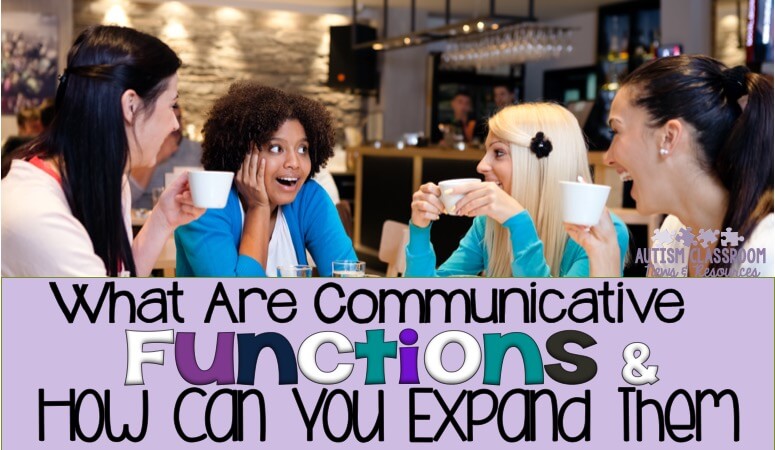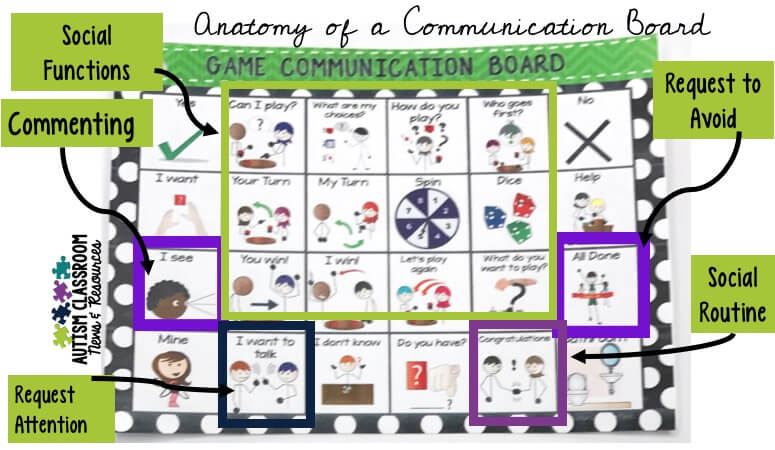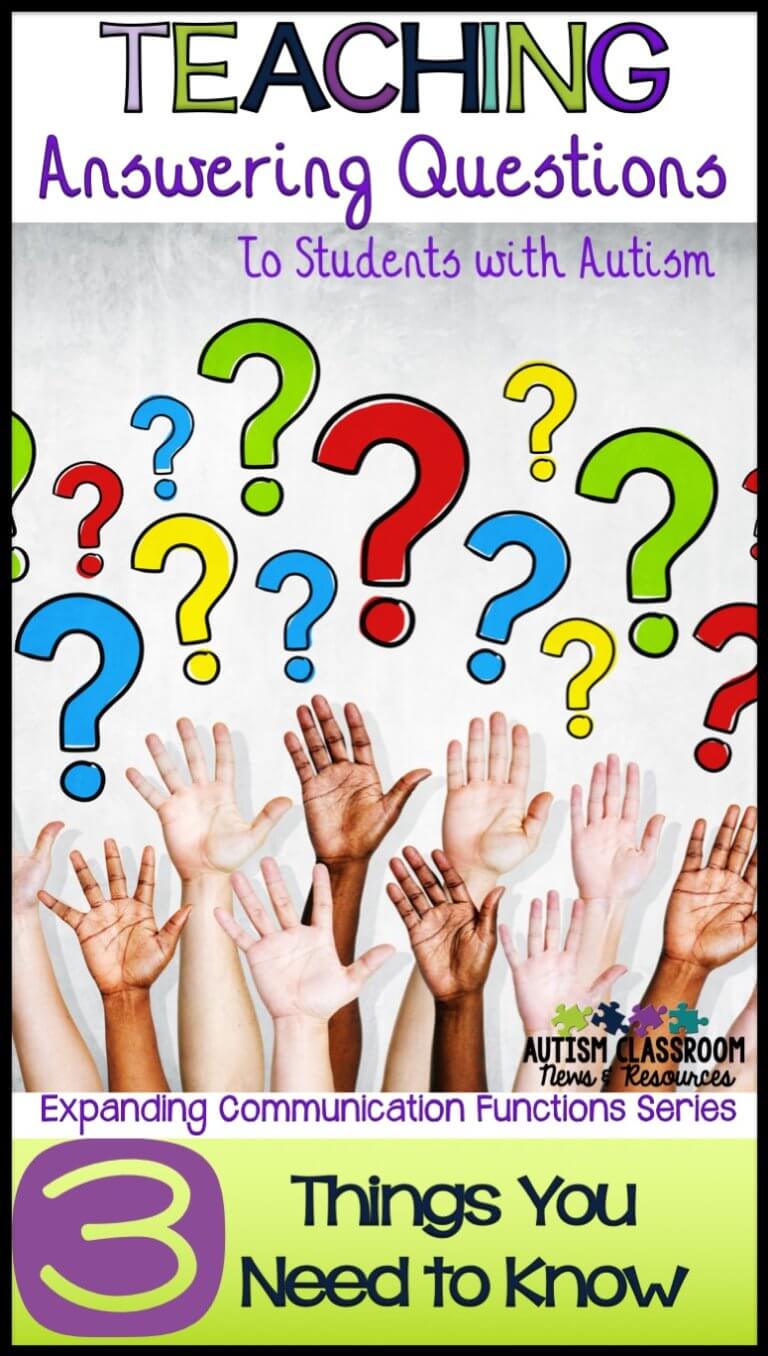Sharing is caring!
In the last post I emphasized important reasons for increasing the communication functions of your students. We spend a lot of time thinking about how many words our students use or how many new words they learn. But, if they can’t communicate effectively for a variety of purposes, then their communication is still very limited. So, what kind of things am I talking about when I say “communicative functions”? And more importantly, how do we increase them?
What Are Communicative Functions?

How do most people define communicative functions? Often, a great extent of the way we classify them depends on how we were trained. For instance, behavior analysts define them differently than speech pathologists. However, I think that the one thing that most practitioners can agree on at this point: Functions matter!
Essentially the communicative functions are the purpose of the communication. What is the individual intentionally or unintentionally trying to convey? Typically, intentional communication is when the communicative message is intended for specific method. I point to a cookie because I want a cookie. I ask for directions to get information.
Unintentional communication is typically when challenging behaviors serve communicative functions. In those cases, the communication process isn’t purposeful from the start. For instance, a child tantrums because he wants the candy (gets something). Or he hits someone to get them to go away (avoids something).
So, if communicative functions are the purpose of communication…what functions should we focus on? I’m going to focus on specific ways to practice alternative communication functions and their active role without worrying about aligning them with specific disciplines.
Regulation of Communicative Functions
When young children communicate in a way to get or avoid something, it’s thought of as a regulation function. These communication functions change the individual’s environment and language development.
Requesting for Items / Activities / Information
Essentially requesting is the word most of us use to describe when someone wants something. The form of the communication is designed to get a desired item or action. Some examples include
- Jim points to juice to get juice
- Deandre verbalizes, “I want the train, please.”
- Jenny exchanges a picture of the hat she wants to wear with her mom.
- I ask directions of how to get to a school I am visiting.
Usually we sabotage the environment and put the child request out of reach. Then there is an opportunity to make the request and reinforce it. This is typically where we start instruction in a functional approach. It’s the most reinforcing function for many of our students who are not as reinforced by social functions. I’ve written several posts about requesting including about teaching initiations of request and setting up opportunities to request.
Refusing or Rejecting Items / Activities
This is exactly what it sounds like. Essentially it’s requesting that something be gone. Behavior analysts would say it’s reinforced by negative reinforcement. The reinforcement value is that something is removed.
- Jim pushes the milk away on the table
- Deandre says, “Leave me alone!”
- Jenny exchanges a picture to ask for a break from work
- I ask if I can leave the county fair because it’s overwhelming
So to teach it we essentially set up situations that set up the negative situation that the person wants to avoid. Then we support them to help them request to end it. I ask Jenny to work and immediately point to the break card. When she exchanges it, work is removed.
I’ve written a post with suggestions and a protocol for teaching students to ask for a break. Asking for a break is essentially rejecting work and this procedure would work for other situations as well.
Social Interaction In Communicative Functions
Requesting Attention
I included this separate from other requests because it involves requesting for social interaction. This sometimes important to some students but for others they aren’t that interested. And many of them develop dysfunctional ways to do it.
- Jim reaches his hands up to get mom to pick him up
- Deandre calls “Mom!” when he wants to talk to her
- Jenny hits a speech-generating device that says, “Please talk to me”
- I call my mom so I can talk to her
To teach appropriate attention seeking, set up situations in which you have the time to attend and then ask the student to work on his or her own. I’ve written more about how to teach this as a replacement skill (with a free download) in this post.
Labeling and Describing
Labeling and naming things are important building language. Clearly labeling simple things makes it easier to request them more efficiently. It also allows you talk about things and activities. Going to the next level of adjectives, adverbs, prepositions, etc. makes it easier to describe things and talk about experiences. Imagine that the person couldn’t tell you the name of something they saw. But they can describe it and you can figure out what it is.
Many of our students learn it receptively with the way we teach. But it does them the most good when they start to use those words to give meaning to something they don’t know how to say. This communicative function also expands what they can say with an AAC tool. It makes requests and comments more specific. And it allows them to use words that are available to them to tell you about something that might not be available. The example of Jim below is a good example of this.
- Jim is shown 2 drinks–juice and milk. He says, “white” and Mom knows he wants milk.
- Deandre tells his mom he ran in the race really fast!
- Jenny indicates she wants to wear the blue shirt with a picture sentence
- I am able to describe someone who helped me at the store so a friend can shop with the same person.
When we teach labeling and describing we often use discrete trials and teach it receptively first (for ideas see this post). Then we work on teaching it expressively. However, we should always make sure that we remember to focus on the expressive part of it. We need the students to use labels and characteristics regularly in their communicative function skills. So to do it, set up situations that require them to specify characteristics to get what they want.
I will come back to this one next week and talk more about ways to create expressive opportunities for this function.
Commenting
This involves providing information, sometimes just for social sharing, on a situation. We often use it as a way to gain social interaction or share an experience.
- Jim says, “cold” when given the milk
- Deandre says it’s cold out today
- Jenny exchanges a picture “funny” when a classmate tells a joke
- I comment on the weather when getting on a hotel elevator
To teach commenting, we first start by teaching characteristics from the communicative functions above. Then we start building it into social routines and expectations. You can pair it with requesting wanted or needed material. We start to teach sentence starters of “I see” and “I hear” instead of just “I want.”
I’ll talk more about this one in the future too because it’s a little tough to get spontaneous commenting.
This communicative functions board gives some examples of the different functions discussed.[/caption]
Social Routines
Social routines are common exchanges that are typically completed for social reasons. Greetings are probably the most common example communication.
- Jim says “hi” when his teacher walks in to the room
- Deandre asks how a friend is feeling
- Jenny responds to a greeting by finding the picture for “good morning” at circle
Social routines I think we are all pretty familiar with because we teach at least the beginnings of them in most classrooms. We typically set up routine situations like having students check in during morning meeting in order to build their communication skills. I use a Who’s Here board to do it. Then when each student checks in, the group says hi or good morning as a verbal task.
I’ll come back with a post of ideas for teaching different sorts of social routines later in the series as well.
Answers Questions
Whereas asking questions is often a request for information, answering one has a social function. We answer questions that are asked because we are socially reinforced for doing it. Typically this is part of conversation or providing information that someone else is requesting. Some questions would also fall under social routines (e.g., answering the question, “how are you?”).
- A neighbor asks for directions to a restaurant and you answer with directions.
- A friend asks for the name of your favorite sports drink and you say, “Gatorade”
To teach answering questions, obviously we ask them. We have to make sure that we vary the types of questions, too. We tend to ask many factual questions during the day. Those are much easier for our students to answer than opinions, yes/no, and other types of questions.
So this one also will get its own post in the future.
Describing / Sharing Experiences and Feelings
And finally (although I’m sure there are more functions out there), describing and sharing experiences, emotional expression and negative feelings are a purely social function and are essential to meet the students social needs.
- Jim says “school-happy” to mean he was happy at school.
- Deandre says he was so excited to win the race
- Jenny uses her AAC device to say, “I went to music today”
This is an important function of communication and is tougher than the others because we don’t always know the student’s experiences or emotional state. This makes prompting and setting it up more difficult. Try having families send in a quick note about their weekend. Send a note home to the parents that gives them information about the student’s day so they can practice. We often also use feeling charts for students to identify emotions. However, it’s a much different thing to label pictures of emotions and actually experience them and express our own.
This will be a topic for the future as well.
There are more communicative functions of language and different disciplines describe and divide them up differently. For instance, verbal behavior in ABA tends to talk about mands (requests), tacts (labels) and intraverbals (language reinforced by social interaction alone). However, I find it easier to focus on how our students will be using their language in their daily lives and not worry as much about the labels.
I hope this gives you a jumping off point for thinking about how to expand language and communicative functions beyond requesting. ‘ll be back next week to talk about labeling and describing.








